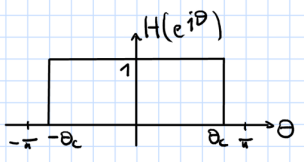Suppose we have an ideal low-pass filter $H(e^{j\theta})$ with a cut-off frequency $\theta_c$ in the range of $0\leq \theta_c \leq \pi$.
I want to know the input signal $x[n]$, as well as the cut-off frequency $\theta_c$, which produces the following output signal $y[n]$.
To solve this I started off with transforming $y[n]$ to the frequency domain by calculating the DTFT:
$$ Y(e^{j\theta})=\sum_{n=-\infty}^{\infty}y[n]e^{-j\theta n}=1+e^{-j\theta}+2e^{-j2\theta}+e^{-3j\theta}+e^{-j4\theta} $$
Now I can calculate $X(e^{j\theta})=\frac{Y(e^{j\theta})}{H(e^{j\theta})}$. This is only possible for $|\theta| \leq \theta_c$, since outside of this region $H(e^{j\theta}) = 0$ and $X(e^{j\theta})$ would approach infinity. But inside this region $H(e^{j\theta})$ is simply 1 and when transforming $X(e^{j\theta})$ back to $x[n]$ it is just the same as $y[n]$, a behaviour that is expected of a low-pass.
The thing I am not sure about is the cut-off frequency. If I simply plot $Y(e^{j\theta})$, I see that there are frequency components until $\pi$. So I could just say alright, $\theta_c=\pi$. But is it really like that? Because the low-pass is actually just dependent on $\theta$ and not all the multiples of it, which I find in the complex exponentials of $Y(e^{j\theta})$. So how do I calculate $\theta_c$?


